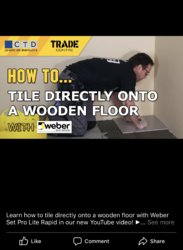Install the app
how_to_install_app_on_ios
follow_along_with_video_below_to_see_how_to_install_our_site_as_web_app

Note: this_feature_currently_may_not_be_available_in_some_browsers
You are using an out of date browser. It may not display this or other websites correctly.
You should upgrade or use an alternative browser.
You should upgrade or use an alternative browser.
Search the forum,
Which thickness ply do you use for testing. I have only ever seen SP101 in 6 and 9mm.
Discuss So forget about cement boards and foam boards and just tile direct onto wood? in the Tile Adhesive / Grout Advice area at TilersForums.com.
The builders will not do much for a tiler, you should know that by now. You would have to take that control yourself, but the priming of the back and side of a ply-board was mainly when the boards were exposed to moisture going onto a groung floor jiosted floor where there was earth below it without a DPM. These floors are becoming less as most new builds are a solid screed and all housing must have a DPM installed.
W
Waluigi
Flooring Grade Class 3 ply-wood or Hansons SP 101 ply-wood fixed at 150mm centers, Tilemaster Primeplus, Tilemaster S1 adhesive. Done and guaranteed.
Which thickness ply do you use for testing. I have only ever seen SP101 in 6 and 9mm.
Best practice will always be Backer-board first. But the correct ply-board type can still be tiled. BS5385 changed last year. I ask why a substrate that the industry tiled to for twenty years that I know of and probably longer is now now longer suitable? What as changed in 6 months? In my role has technical support we go out to failure on ply-board but mostly they are of the incorrect type and not suitable for tiling from the start. The soft flooring industry use thousands of ply-board sheets every day and pour thousands of gallons of water based smoothing compounds over them and we get zero phone calls with debonding issues. Why can their industry be able to acheive this when the tiling industry acording to BS5385 need to be protected from this "not suitable" substrate. Nobody from BS contacted Tilemaster for our input has to whether Tilemasters adhesives are suitable and have been since Tilemaster developed them, and will continue to be suitable for fixing tiles to suitable ply-boards.
J
J Sid
yes the BS has changed, why? That question is way above my pay grand.
the hard part from my, a lowly tiler, is getting the builder/chippy/home owner to use and prepare the wooden flooring in a manner so products such as yours can be used. Just will not happen, so much easier to overboard or recommend a flooring other then wood.
the hard part from my, a lowly tiler, is getting the builder/chippy/home owner to use and prepare the wooden flooring in a manner so products such as yours can be used. Just will not happen, so much easier to overboard or recommend a flooring other then wood.
D
Dumbo
I have to agree with you as I have also seen the failure at floor joint that has had hardie used on it .and how does an adhesive that can stick a tile to the correct wood flooring type handle the joints in said correct floor?
this is where most failures happen imho
Exactly has it would on a backer boarded floor. First and formost the floor must be strong, no deflection and capable of supporting the tiling installation. BS 5385. The ply-board is only there to over lay an unsuitable substrate ie: chip-board, floorboards. If the main floor structure is not up to it yes the edges are where most failures occur. Is that the ply-board failing or the structure of the floor not being suitable in the first place.
F
Flintstone
My thoughts on plywood is that it's probably the worst overlay surface you can tile onto and the sooner it's deemed unacceptable the better. Yes there are as Glynn says a couple of types of ply that are ok, but we all know that the important part of the spec of the ply wood gets lost in translation or disregarded and people end up buying builders yard 9mm ply. As for this Webber adhesive, well simply why would you risk it ?
Reply to So forget about cement boards and foam boards and just tile direct onto wood? in the Tile Adhesive / Grout Advice area at TilersForums.com
Make sure to mark a post as a solution for better transparency.
There are similar tiling threads here
-
- Question
Hi,
Can't seem to find a solid answer as I realise so much depends on multiple factors.
I'm planning to tile my kitchen floor with 8mm porcelain floor tiles (660x440mm).
My kitchen floor is...
- Scott9
- America Tile Forum
- 0
- 2K
- Replies
- 0
- Views
- 2K
Hello there,
Relatively recently we had a new en-suite fitted (complete rip out of the old fittings, and old wall tiles and floor carpet). This consisted of a quadrant shower enclosure, a...
- AndyZR81
- The Welcome Forum
- 5
- 2K
- Replies
- 5
- Views
- 2K
Posting a tiling question to the forum? Post in Tilers' Talk if you are unsure which forum to post in. We'll move it if there's a more suitable forum.

